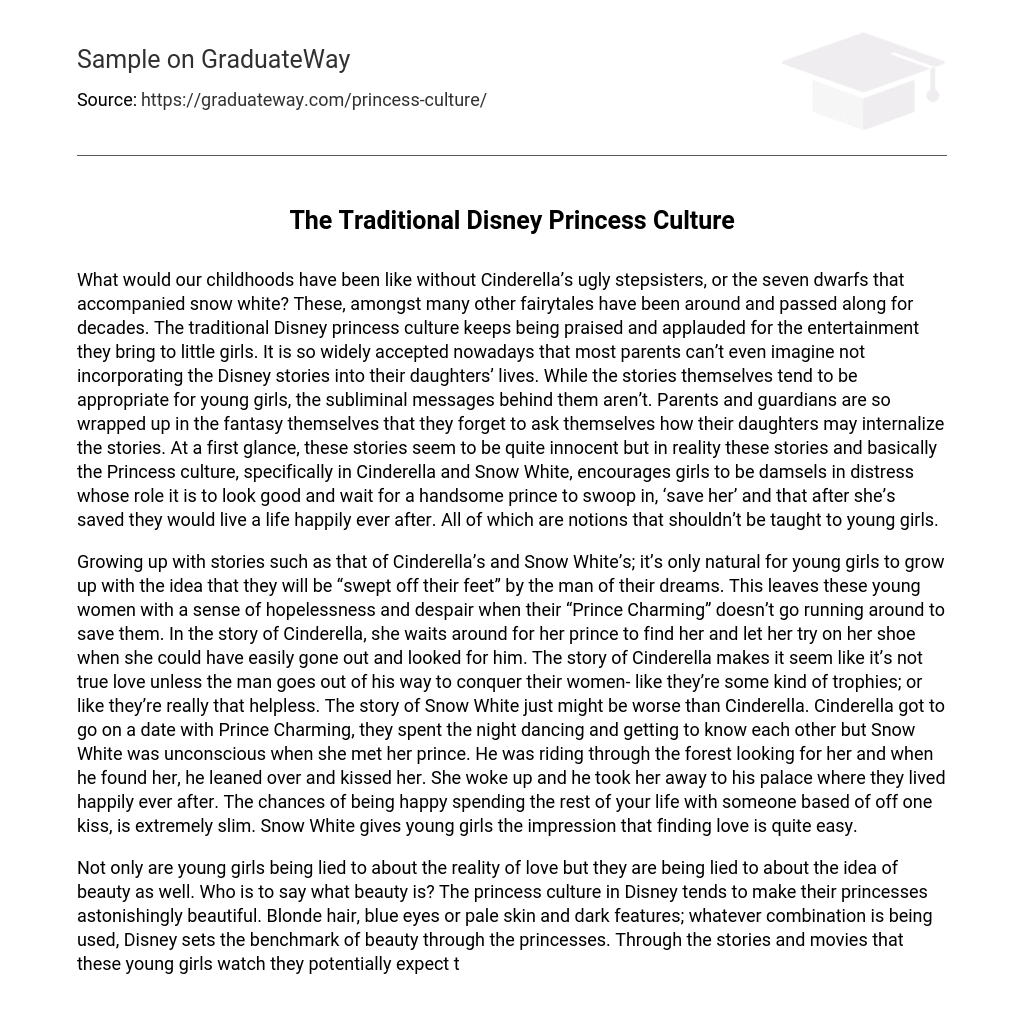Without Cinderella’s unattractive stepsisters or the seven dwarfs accompanying Snow White, our childhoods would have been very different. These fairytales, along with others, have been passed down for years. The traditional Disney princess culture is celebrated and cherished for entertaining young girls. Nowadays, it is widely accepted and most parents cannot imagine not incorporating these Disney stories into their daughters’ lives. However, while the stories themselves are suitable for young girls, they contain underlying messages that should not be ignored. Parents and guardians become so immersed in the fantasy that they overlook how their daughters might interpret these stories.
At first glance, the stories may appear innocent; however, they actually promote a Princess culture that encourages girls to depend on a handsome prince to rescue them and lead them to a “happily ever after” life. These ideas should not be taught to young girls.
Many young girls are raised with tales like Cinderella and Snow White, which can establish unrealistic expectations of being saved by their “Prince Charming.” This can result in feelings of hopelessness and despair when their ideal partner doesn’t magically appear. In the story of Cinderella, she waits for her prince to find her and place a shoe on her foot instead of taking control herself. This narrative implies that true love is only genuine if the man goes above and beyond to win over the woman, treating them as trophies or portraying them as helpless. On the other hand, Snow White’s story may be even more problematic than Cinderella’s. Unlike Cinderella, Snow White is unconscious when she meets her prince. He searches for her in the forest and wakes her up with a kiss, instantly whisking her away to his palace for a happily ever after. The chances of finding lasting happiness based solely on one kiss are extremely slim; nevertheless, Snow White suggests that discovering love is effortless.
Disney’s princess culture promotes unrealistic beauty standards and distorts young girls’ understanding of beauty. The Disney princesses are often depicted as exceptionally beautiful, with features like blonde hair, blue eyes, pale skin, and dark features. This narrow definition of beauty may pressure young girls to conform. However, when they realize they cannot meet these expectations, it can negatively impact their self-esteem, making them feel unattractive. It is crucial to acknowledge that possessing similar attributes to Cinderella and Snow White does not automatically make someone more beautiful or increase their chances of finding happiness. Disney neglects to showcase the diverse range of beauty among young girls.
Despite the existence of false ideas about love and beauty portrayed by Disney princesses, the misconception of a “happily ever after” surpasses them. Disney stories and movies tend to create the illusion that finding a man guarantees happiness. Moreover, Disney misleads young girls into believing that happiness does not require effort. The notion of a simple and idyllic life after finding a prince is misleading, as it fails to capture the complexities of maintaining a successful relationship. The stories of Cinderella and Snow White depict their post-prince lives as blissful and problem-free, disregarding the real challenges faced in love. By omitting the less glamorous aspects of love, Disney creates unrealistic narratives. While Disney’s princess culture may have been acceptable in previous generations, it fails to keep up with the increasing independence of women. These tales, such as Cinderella and Snow White, undermine the progress made by women. Not only do these stories confine the independence of young girls, but they also make their lives more difficult. Being a girl is already challenging without growing up to realize that their childhood was built upon falsehoods.The stories of this nature perpetuate the belief that girls derive their worth and importance solely from their association with men. This can lead to girls feeling trapped and undervalued, as their own inherent worth is undermined.





